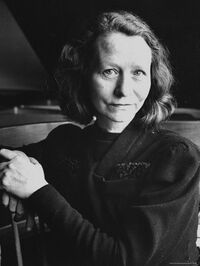Edna St. Vincent Millay: Difference between revisions
No edit summary |
No edit summary |
||
| (One intermediate revision by one other user not shown) | |||
| Line 1: | Line 1: | ||
[[Category:Influences on Morrissey - Literature]] | [[Category:Influences on Morrissey - Literature]] | ||
[[Category:Concert Backdrop]] | [[Category:Concert Backdrop]] | ||
[[File:EdnaSTVincentMillay.jpg | 200px | right | thumb |Edna St. Vincent Millay]] | |||
==Relevance== | ==Relevance== | ||
Image used as a backdrop in 2016. | Image used as a backdrop in 2016. | ||
| Line 8: | Line 9: | ||
</gallery> | </gallery> | ||
{{Page | {{Page | ||
|FeaturedImages=File:Edna St. Vincent Millay Portrait (c. 1920).jpg | |||
|WikipediaPageTitle=Edna_St._Vincent_Millay | |WikipediaPageTitle=Edna_St._Vincent_Millay | ||
}} | }} | ||
{{PageDate}} | {{PageDate}} | ||
Latest revision as of 14:26, 16 April 2023
Relevance
Image used as a backdrop in 2016.
Wikipedia Information
 |
Edna St. Vincent Millay (February 22, 1892 – October 19, 1950) was an American lyrical poet and playwright. Millay was a renowned social figure and noted feminist in New York City during the Roaring Twenties and beyond. She wrote much of her prose and hackwork verse under the pseudonym Nancy Boyd. Millay won the 1923 Pulitzer Prize for Poetry for her poem "Ballad of the Harp-Weaver"; she was the first woman and second person to win the award. In 1943, Millay was the sixth person and the second woman to be awarded the Frost Medal for her lifetime contribution to American poetry. Millay was highly regarded during much of her lifetime, with the prominent literary critic Edmund Wilson calling her "one of the only poets writing in English in our time who have attained to anything like the stature of great literary figures. By the 1930s, her critical reputation began to decline, as modernist critics dismissed her work for its use of traditional poetic forms and subject matter, in contrast to modernism's exhortation to "make it new." However, the rise of feminist literary criticism in the 1960s and 1970s revived an interest in Millay's works.


